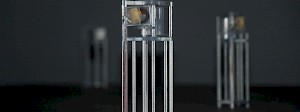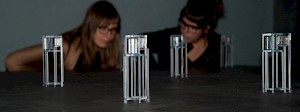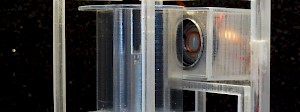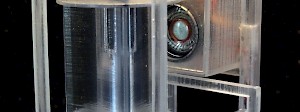Miniatuur Aernoudt Jacobs 2011
In our everyday environment, we are not only confronted with a murmur of sounds, which is the result of our actions, but also with the phenomena that affect these sounds. This intertwinement gives our perception of the everyday sound environment an ephemeral and subjective character.
Miniatuur is a kinetic sound installation that plays with the physical laws of sound. Mechanisms, through which sounds exist and are created, are revealed. Twenty-five miniature sound objects are placed on a table. Some of the object holds a tiny speaker and a rotatating reflector. The speaker amplifies field recordings of natural noises like wind, crickets, water... The reflector modulates these sounds in a purely acoustic way by acting on physical aspects: air, reflection and movement. The reflector is a rotating flywheel with specially shaped panels. The circular motion of the reflector distorts, disrupts, bounces the physical properties of sound waves. The sound changes dynamically, depending on the movement of the flywheel.
Manipulating sound through movement is in this connection an interesting concept because, sonically, it detaches sounds from the sound source. Sound is essentially a change of air pressure. Sound is moving air, but not all the air that moves is sound... Wind becomes sound as it blows around our ears, when it settles in tiny spaces, a fissure, a tube. Wind becomes audible when it sets objects in motion. Like leaves on a tree, a waving flag.
Miniatuur challenges the laws of sound. Sound is perceived as a dynamically changing sonic landscape. It is a physical reinterpretation of a field recording. Moreover, together with the sonification of these field recordings, the circular motion of the reflectors adds a physical sensation of moving air. The perception of these two similar elements is perceived as a highly tangible sensation.
Miniatuur is also the first installment (and inspiration) from research of the empirical sound theories of the 19th century by Henrich Helmholtz, Rudolph Koenig, Jules Antoine Lissajous… What particularly fascinates me in their research is that their investigations where based on solely acoustic phenomena. There were no electronics involved, everything was analysed with analog or mechanical devices. This makes their findings very palpable and understandable. Causes and effect are based on "direct" evidence.
The confrontation today with this 19th century empiricism is appealing because it puts the technology of yesteryear in a interesting perspective. The hi-tech resources of today can be adequately used and confronted with the principles of yesteryear. It stimulates inspiration and thought.
Concept : Aernoudt Jacobs Coproduction : Werktank, STUK, Overtoon Electronics : Techdesign With the support of the Flemish Community Commission (VGC), Flemish Community Thanks: Eveline Lambrechts, Stijn Demeulenaere, Kurt D'haeseleer, Ief Spincemaille, Marc Lambaerts (Fablab Leuven), Ann Heyman, Pieter-Paul Mortier and STUK Crew





